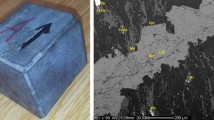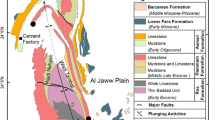Abstract
Laboratory measurements are required to study geophysical properties of the subsurface because of lacking direct observation of Earth’s crust. In this research, compressional (P) and shear (S) wave velocity measurements have been conducted on cylindrical specimens of Quartz-micaschist cored using rock blocks taken from the zinc and lead Angouran mine, Zanjan, northwest of Iran. Cylindrical rock specimens were prepared from the blocks by coring in 0°, 30°, 45°, 60°, and 90° into the foliation direction. P- and S-wave velocities were measured along the cylindrical specimens with different foliation orientations. Percent variations of the P- and S-wave velocities (Thomsen’s anisotropic parameters ε and γ) and constant dynamic modulus of test results have been determined. Percent variations of the P-wave velocity (ε) increase with an increase of the foliation angle with respect to the propagating waves direction by a parabolic function as it shows P-wave velocity differences up to a maximum value of 50 %. Thomsen’s anisotropic parameter of γ has also the same function with the foliation angle. Meanwhile, foliation orientation has a much greater influence on ε than γ for foliation angle from 45° to 90° as \( \frac{\varepsilon }{\gamma } \) ratio increases with an increase of foliation angle. Values of dynamic elastic modulus (E), Poisson’s ratio (ν), shear modulus (μ), bulk modulus (K), and Lamé’s constant (λ) increase with the increase of foliation angle with the parabolic function. The results show that dynamic elastic modulus, Poisson’s ratio, shear modulus, bulk modulus, and Lamé’s constant have anisotropic behavior in relation with the foliation orientation.














Similar content being viewed by others
References
Anderson DL, Minster B, Cole D (1974) The effect of oriented cracks on seismic velocities. J Geophysics Res 79:4011–4015
Babuska V (1981) Anisotropy of Vp and Vs in rock-forming minerals. J Geophysics 50:1–6
Backus GE (1962) Long-wave elastic anisotropy produced by horizontal layering. J Geophysics Res 67:4427–4440
Borg G, Daliran F (2005) Genetic aspects of the Angouran non sulfide zinc ore deposit, NW-Iran as an exploration guide for non sulphide zinc ores, mining and sustainable development, 20th Word Mining Congress, Tehran—Iran.
Cholach PY, Schmitt DR (2006) Intrinsic elasticity of a textured transversely isotropic muscovite aggregate: comparisons to the seismic anisotropy of schists and shales. J Geophys Res 111:410–427
Crampin S, Bamford D (1977) Inversion of P-wave velocity anisotropy. Geophys J Intl 49:123–132
Crampin S, Kirkwood SC (1981) Velocity variation in systems of anisotropic symmetry. J Geophysics 49:35–42
Crampin S, McGonigle R, Bamford D (1980) Estimating crack parameters from observations of P-wave velocity anisotropy. Geophysics 46:345–360
Ebrahimi MH, Aftabi A, Mohamadi R (2010) Structure, texture, mineralogical and geochemical feature and the pattern of the Angouran ore deposit in the Sedex-VMS-MVT triangle. Petrology 1st year 3 (Autumn).
Gilg HA, Allen C, Balassone G, Boni M, Moore F (2003) In: Eliopoulos et al (eds) The 3-stage evolution of the Angouran Zn “oxide”-sulfide deposit Iran mineral exploration and sustainable development. Millpress, Rotterdam
ISRM (1978) Suggested methods for determining sound velocity International Society for Rock Mechanics Commission on Standardization of Laboratory and Field Tests. Int J Rock Mech Mining Sci Geomechanics Abstracts 15:53–58
Kern H (1990) Laboratory seismic measurements: an aid in the interpretation of seismic field data. Terra Nov. 2:617–628
Kim H, Cho JW, Song I, Min KB (2012) Anisotropy of elastic moduli, P-wave velocities and thermal conductivities of Asan gneiss Boryeong shale and Yeoncheon schist in Korea. Eng Geol 147:68–77
Nikrouz R (2005) Three-dimensional (3D) three-component (3D) shallow seismic refraction surveys across a shear zone associated with dryland salinity at the spicers creek catchment. Ph.D thesis School of Geology NSW Sydney Australia.
Nur A (1971) Effects of stress on velocity anisotropy in rocks with cracks. Geophysical Research 76:2022–2034
Palmer D (2001) Measurement of rock fabric in shallow refraction seismology. Explor Geophys 32:307–314
Patella D, Maria Patella S (2009) Geophysical tomography in engineering geological applications: a mini-review with examples. The Open Geology Journal 3:30–38
Saki A (2010) Mineralogy, geochemistry and geodynamics setting of the granitoids from NW Iran. Geol J Wiley InterScience doi:10.100 2/gj 1211.
Song I, Suh M (2014) Effects on foliation and microcracks on ultrasonic anisotropy in retrograde ultramafic and metamorphic rocks at shallow depths. J Appl Geophys 109:27–35
Takanashi M, Nishizawa O, Kanagawa K, Yasunaga K (2001) Laboratory measurements of elastic anisotropy parameters for the exposed crustal rocks from the Hidaka metamorphic belt, Central Hokkaido Japan. Geophys J Intl 145:33–47
Tatham RH (1982) Vp/Vs and lithology. Geophysics 47:336–344
Thomsen L (1986) Weak elastic anisotropy. J Geophysics 51:1954–1966
Tsvankin I (1997) Anisotropic parameters and P-wave velocity for orthorhombic media. J of Geophysics 62:1292–1309
Willis HA, Rethford GL, Bielanski E (1986) Azimuthal anisotropy: occurrence and effect on shear wave data quality. 56th Ann Internat Mtg, Soc Expl Geophys, Expanded Abstracts 479–481.
Winterstein DF (1986) Anisotropy effects in P-wave and SH wave stacking velocities contain information on lithology. Geophysics 51:661–672
Winterstein DF (1990) Velocity anisotropy terminology for geophysicist. Geophysics 55:1070–1088
Author information
Authors and Affiliations
Corresponding author
Rights and permissions
About this article
Cite this article
Nikrouz, R., Moomivand, H. & Azad, R. Effect of foliation orientation on the P- and S-wave velocity anisotropies and dynamic elastic constants of the quartz-micaschists metamorphic rocks, Angouran mine, Iran. Arab J Geosci 9, 669 (2016). https://doi.org/10.1007/s12517-016-2699-9
Received:
Accepted:
Published:
DOI: https://doi.org/10.1007/s12517-016-2699-9




